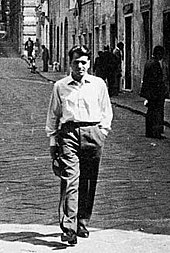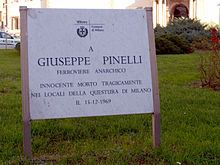Giuseppe Pinelli
Giuseppe "Pino" Pinelli (born October 21, 1928 in Milan , † December 15, 1969 ibid) was an Italian anarchist activist. He died after being arrested in the custody of the Italian police . Pinelli was a member of the Milanese anarchist circle Ponte della Ghisolfa (Bridge of Ghisolfa, a district of Milan). He was also secretary of the Italian branch of the anarchist Black Cross . His death at the hands of the police inspired Dario Fo's play Morte accidentale di un anarchico (The Accidental Death of an Anarchist).
Life
Pinelli was born into a working class family. He worked as a messenger and later as a warehouse worker, but found time to read and became active in an anarchist group in the Milan area around 1944. He later joined other groups, including the one that published the weekly Il Libertario . In 1954 he became a railroad fitter. In 1955 he married Licia Rognini, whom he had met in an evening course in Esperanto . During the 1960s he continued with anarchist activities. In 1963 he organized young anarchists in the Gioventu Libertaria (Libertarian Youth). In 1965 he helped found the Sacco and Vanzetti group and in 1968 founded the circolo anarchico Ponte della Ghisolfa mentioned above .
Circumstances of death
On December 12, 1969 , a bomb exploded in the “Banca dell'Agricoltura” (agricultural bank ) in Piazza Fontana in Milan, killing 17 people and injuring 88 others. Pinelli was arrested and interrogated with other anarchists. He was detained and questioned for three days, longer than Italian law allows for people who have not been brought before a judge. Shortly before midnight on December 15, 1969, Pinelli was seen falling to his death from a window on the fourth floor of the Milan police building. The three police officers, including Commissioner Luigi Calabresi , who interrogated Pinelli, were charged with murder in 1971. For lack of evidence, the case was dropped and it was found that Pinelli's fall was an accident.
Pinelli's innocence in the bombing was later clarified, and right-wing Ordine Nuovo was charged with the 1969 attack on Piazza Fontana. In 2001 three Italian neo-fascists were convicted but acquitted on appeal .
reception
Pinelli's death served Dario Fo as inspiration for his play "Accidental Death of an Anarchist". Pinelli's name is not mentioned in the original draft.
The interrogation and the death of Pinellis in the hands of the police are the subject of the story “Talking is deadly, silent too” by Peter O. Chotjewitz , published in 1969 by Eremiten Verlag Düsseldorf.
Pinelli's death was the subject of the central painting Funerali dell'anarchico Pinelli (funeral of the anarchist Pinelli) by the Italian artist Enrico Baj and the political documentary film 12 December (1972) by Giovanni Bonfanti based on an idea by Pier Paolo Pasolini .
In addition, the episode film Documenti su Giuseppe Pinelli emerged in 1970 as an examination of the topic .
In 1977, on a private initiative, a memorial plaque was erected in Piazza Fontana, which the Milanese police made explicitly responsible for Pinelli's death. After heated controversy, a new plaque was erected in 2006, on which only the "tragic death" of Pinellis is mentioned.
Web links
- La ballata del Pinelli (The ballad of Pinelli) (ital.)
- Biography on libcom.org
Individual evidence
- ^ Né omicidio né suicidio: Pinelli cadde perché colto da malore , La Stampa, October 29, 1975.
- ↑ Fabian Tietke: counter-investigation. Pasolini and Lotta continua - a re-reading. In: CARGO Film / Medien / Kultur, No. 24 (December 2014-February 2015), pp. 68–73.
- ^ John Foot : Divided Memories in Italy. Stories from the Twentieth and Twenty-first Centuries. In: Hannes Obermair , Sabrina Michielli (ed.): Cultures of remembrance of the 20th century in comparison - Culture della memoria del Novecento al confronto. (Booklets on the history of Bolzano / Quaderni di storia cittadina 7). Bozen: Stadt Bozen 2014. ISBN 978-88-907060-9-7 , pp. 182–185 (in detail on the controversy and with an illustration of the plate removed).
| personal data | |
|---|---|
| SURNAME | Pinelli, Giuseppe |
| ALTERNATIVE NAMES | Pinelli, Pino (nickname) |
| BRIEF DESCRIPTION | Italian anarchist activist |
| DATE OF BIRTH | October 21, 1928 |
| PLACE OF BIRTH | Milan |
| DATE OF DEATH | 15th December 1969 |
| Place of death | Milan |


